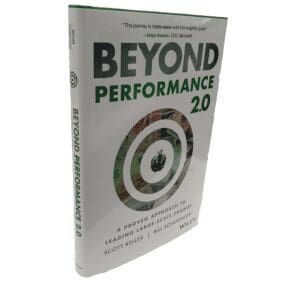This brilliant new book emphasises the importance of a bespoke approach to large-scale change because copying and pasting ‘best practice’ ideas onto an organisation, hasn’t got the legs for the long haul. The need to make informed and correct choices about changes specific to an organisation has never been so crucial, and this rings home with Masters in Minds because we have a number of tools available to correctly identify the change required from the ‘shop floor’ to the C-suite.
Change is Constant…
I absolutely love reading what is now a multitude of ‘how to’ articles that appear on LinkedIn about corporate/culture; change/transformation; management/managing; people/managing; managers/leadership; performance; ……..you get the idea.
I’m super curious as to the success rate of coaching courses in the aforementioned subject matters because if we went by the number of advice pieces arriving on our screens each day we could easily be forgiven for thinking that the courses aren’t delivering or that no one is listening, or more likely the good advice given on the course is not being put into practice.
I’m not in the least bit surprised by this given that most workplace interventions require a change to happen. Something as trivial as removing free biscuits and fruit from the office can be ‘gamechangers’ in some people’s eyes and these items might seem trivial to a lot of us but there’s one thing many humans don’t take kindly to and it is change in any form, but when you think about it is very strange given that change is a constant in our lives from the day we are born. There is in fact nothing more natural for a human being than change.
So, the question about change then becomes more interesting. If it’s not change per se, maybe it’s actually being the architect of the change that we find difficultly with, or lack the skills required, to make change happen. So, if change promises an escape from the mundane, from the creaky see-saw of the everyday and is why the journey of change is embarked upon, why isn’t it fully embraced as a positive move and followed through to the end?
The Book…
To start the search for a solution I’d like to point you in the direction of a terrific new book, ‘Beyond Performance 2.0 – A Proven Approach to Leading Large-Scale Change’. Now before you accuse us of writing our own self-fulfilling prophecies and telling you how good they are, this is not a book from Masters in Minds (not yet), Beyond Performance 2.0 has been written by the consulting giant that is, McKinsey & Co – and this new book sits perfectly in their body of excellent research materials. What’s exciting about Beyond Performance 2.0 is that they really do try to address the issue of change and the all too common phenomena of executives grafting off the shelf ‘copy & paste’ change solutions onto an organisation not yet ready to accept them.
In general, a ‘copy & paste’ solution means sending staff on courses that are designed from the outside-in and so are in a general sense non-specific to the staff attending them. By incorrectly identifying the issue in the first place engages the ineffective ‘copy & paste’ solution which ultimately disengages the staff who in their eyes have been sent on a course to solve a problem that even they didn’t know they had, and now you have very stubborn resistance to change.
Beyond Performance 2.0 highlights the importance of a bespoke approach being applied to each and every problem and at Masters in Minds we couldn’t agree more, especially when we deploy our insight tool called the Mindset Indicator and a bespoke Discovery Lens which we have effectively used to design bespoke solutions for a wide range of clients for many years.
The authors of the book have written about the hard and soft elements of change. What they mean by those terms is this, ‘hard’ skills are the process driven parts of business, ‘soft’ skills are the human interaction side of things (I would argue that they should be the other way around or at least not described so diametrically but that’s a whole other cultural change!) Believe it or not, these human interaction skills have up until recently been all too easily dismissed as ‘nice to haves’, ‘non-measurable’, and ‘not essential’ to running a successful business. Now however, there’s some powerful research from McKinsey that show a clear connection between positive effective human interactions and a sustained upswing in productivity.
According to McKinsey research, Coca-Cola were going south in the 1990s turning huge chunks of market share over to Pepsi Cola and in turn losing the shareholders large sums of money.
A new leader of Coca-Cola was brought in, Neville Isdell, and by the time he had finished, staff turnover was down by 25%; employee engagement jumped to ‘unprecedented levels’ never seen before, communication and awareness of company goals rose to 76% up from 17%, and perhaps the most important for many leaders today, employee positive views of company leadership rose by 19%.
McKinsey, in their new book, list these improvements under the title of ‘Performance’ and along with these metrics sit all of the obvious measures that all companies are measured by, operating profits, return on investment, shareholder returns, net operating costs and countless others depending how large your organisation is….you get the idea.
Of course, these are all measurable ‘performance’ results from some sort of intervention.
What’s not so obvious unless you’re lucky enough to be in my world, are the effects had on these measurables from the so called ‘soft’ skills. Isdell himself said it was because he put as much effort into the ‘How, as the What’, and the authors here pull the ‘soft skills’ and the ‘how’ together under the title of ‘Health’, which McKinsey define as being, ‘about how effectively an organisation works together in pursuit of a common goal.’
They go on to say that health can be evaluated in terms of accountability, motivation, coordination, innovation, and that ‘a way to think about health related actions is that they are those that improve how an organisation internally aligns itself, executes with excellence and renews itself to sustainably achieve performance aspirations in its ever-changing external environment.’
Let’s just take a second to understand for a moment what they are saying here, and please remember that they don’t make these claims lightly. They say that a healthy organisation, one with an equal emphasis on ‘soft’ and ‘hard’ skills, has improved internal alignment, executes everything it does at the very highest level, and constantly embraces sustainable change to stay competitive. Wow. I don’t know about you but achieving those three desirables doesn’t sound like ‘soft’ stuff to me at all, they sound more like the fundamental elements upon which to create any type and size of organisation.
To reinforce their results, it’s worth taking a moment to appreciate the scale of McKinsey’s research and the extensive data set used by them to reach their conclusions is quite staggering:
• Over 5 million data points (people like you and me)
• More than 2,000 organisations spread around the globe
• Data from 32,000 McKinsey Quarterly Surveys
• Data & Learning from more than 1,000 of McKinsey’s own clients specifically relating to Performance and Health.
• In-depth reviews of more than 9000 top tier managements books and academic journals.
• Data from McKinsey’s ‘Wave’ implementation tracking solution software used by over 600 clients.
• Learnings from over 150 change leader’s client seminars
• One-on-One interviews with CEOs
To argue against their conclusions is pretty difficult.
The Theory at Work
For the last twelve years Masters in Minds have advocated the use of ‘soft’ skills in all of their interventions and have been leading the way with this approach. So, what does a so-called ‘soft’ skill look like in real terms in the everyday the here and now, and how do you know that you’ve got the right soft skills in play within your organisation?
At Masters in Minds we put all our emphasis on a philosophy that is born out of thousands of years of philosophical thought, BE-DO-HAVE. This simply means, the human ‘BE’ing drives the human ‘DO’ing and that drives outcomes/results that you HAVE. Our programmes and interventions are designed and delivered from this mindset.
There is a reason why 70% of large-scale transformations fail, and it’s because 50% of the workforce are not aligned to the change. There is probably a very good reason that this statistic exists because as I touched on at the beginning, organisations don’t place the human BEing at the starting point for all their transformation/change efforts. Remember the non-specific copy & paste solutions? They are all coming from the outside-in, instead of inside-out, i.e., the change starting point is with your people.
Some of the resistance to change initiatives stem from the perceived disruption to established power structures, long memories of tenured staff who have ‘seen it all before’, and something I call negative inertia networks (NiNs) which if you look hard enough you’ll find lurking in your silos if you have them, and you probably do.
Now I’m not saying that there’s no value in putting staff through a series of copy & paste courses, I’m asking how effective they are at delivering change, transformation and continuous improvement.
From my experience of ‘off the shelf’ courses, they’re first and foremost enjoyable, and most of your people will come back refreshed and will wax lyrical about how the team now feels more ‘together’ (note – identifying in what way they define more ‘together’ would be a good debrief question to ask) and everyone is happy because it feels like the problem has been resolved, but not more than three to four weeks later the same old problems start to show up and before you know it the team is back to square one, or so it seems. Don’t despair, there was some good from the course. They obviously bonded, albeit for a short time and it did last, albeit for a short time – but there are kernels of hope around that all to brief lasting bond which means change can be delivered if handled correctly.
But what happened, why didn’t the bonding last for very long? The truth of the matter is this, it’s simply down to natural human behaviour. There’s an average of three weeks before someone gets bored with a new gadget, piece of clothing, idea, or experience. I once spilled a bag of Tablet (a very sweet Scottish confection harder than fudge and crumbly) in my new car all over the seats and the carpet, but that wouldn’t have happened in the four weeks previous to that point because I was still ‘owning’ the newness of the car and no food was allowed inside but then the ‘new’ became the business as usual because I had passed through the excitement period of ‘owning’ the new car to it now becoming just another car, the allowing of Tablet in the car emphasised the fact that the car had become just another thing in my life.
Owning something be it material or emotional, is the difference between engaging with the material on a journey and not. That ‘off the shelf’ course was just like buying someone a gift that they didn’t know they wanted, no matter that the intention was good but truth is that the idea of what someone wanted or needed was not aligned to the reality, and lo and behold within a few weeks it’s been forgotten about in the everyday hubbub of the modern workplace. If you want any new course of learning to be effective and for it to have long-term positive impacts on your teams, the team (including yourself) have to be aligned to the goal you identified correctly at the start, which can be done with our Mindset Indicator and Discovery work.
We see this often in our line of work where a change is necessary, a transformation begun, and then a bogging down of inertia (50% not aligned with the change remember) and although the reason why it’s bogged down is probably known or can be best guessed at, what’s not known is how to shift the obstruction so the transformation can continue. We’ve discovered at Masters in Minds that the solutions companies seek to bring about effective change are already in the workforce, it’s just that no one’s thought to ask them yet, and then the journey to effect that change is another story altogether but it’s no surprise to learn that the successful ones start with the human BE-ing because the common factor in all courses, interventions, monthly meetings, daily brainstorms, etc, is us. People. The most important resource in any organisation. It’s us. It’s all about us. It always has been. That includes everyone in the organisation.
Just like the authors of Beyond Performance 2.0 we’ve found from research into our many client’s own uplift in performance, that staff attending our Mindset & Leadership Development Programmes achieve more effective results over a much longer period of time compared to the directive coaching courses which try and answer the ‘performance’ problems before the more complex ‘health’ issues are understood.
So, what does ‘Health’ look like at Masters in Minds? Well, it all starts with Thoughts, Beliefs, Purpose, Values, Attitudes, Perceptions, and Emotions. These are the factors that form your aspirations and goals. After these some key principles move the culture forward e.g., role modelling, asking questions, not being afraid to be wrong, communication, responsibility and so many others.
The human Be-ing drives the human DO-ing to deliver you the effective Outcomes/Results that you desire – it can only be that way round.
If you want to find out more then please feel welcome to ch**@ma************.com




































